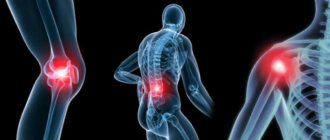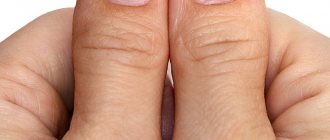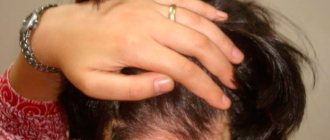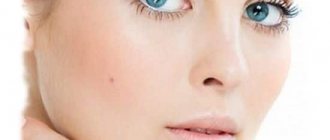When a person has excessive sweating, there can be two types of reasons: external (primary) and internal (secondary) .
External reasons include:
- heredity;
- individual physiological characteristics of the body;
- poor personal hygiene;
- wearing airtight closed shoes (often rubberized);
- wearing synthetic hosiery and clothing.
Secondary hyperhidrosis occurs when excessive sweating is caused by a medical condition. This is a less common type and is more likely to cause sweating throughout the body.
The following diseases lead to internal causes:
- Endocrinological profile (thyrotoxicosis, diabetes mellitus, menopausal syndrome, hypoglycemia, acromegaly).
- Infectious profile (tuberculosis, septicemia).
- Neurological (parkinsonism, stroke, syphilis).
- Menopausal hot flashes (often cause night sweats in women).
- Low blood sugar.
- Some types of cancer.
- Cardiovascular diseases.
- Obesity.
- Mental health problems (vegetative-vascular dystonia, panic attacks, phobias, etc.).
- Acute alcohol or drug poisoning.
Types of hyperhidrosis
Hyperhidrosis is divided into primary and secondary, generalized and local.
- Generalized (generalized) hyperhidrosis. Manifested by increased sweating of the entire surface of the body.
- Local hyperhidrosis. It can appear on any part of the body, but most often in the armpits, palms and soles, face i Batyrshina S.V. Hyperhidrosis: method of correction / S.V. Batyrshina, L.A. Khaertdinova // Practical medicine. -2014. — No. 8 (84). — P. 16-23. .
- Primary (essential) hyperhidrosis. Appears for unknown reasons or spontaneously. In patients with primary hyperhidrosis, both an increase in the number of sweat glands and an increase in their reactivity to ordinary stimuli were noted. Typically, this variant of hyperhidrosis manifests itself from childhood, sharply intensifying during puberty. About 40% of patients note the presence of hyperhidrosis in one of the parents i Batyrshina S.V. Hyperhidrosis: method of correction / S.V. Batyrshina, L.A. Khaertdinova // Practical medicine. -2014. — No. 8 (84). — P. 16-23. .
- Secondary hyperhidrosis. Develops in various diseases and conditions (pathological and normal). Usually of a generalized nature.
Normal sweating
Hyperhidrosis is not a disease, but rather an individual characteristic of the body, which causes a lot of trouble in everyday life. Normally, increased sweating is a common reaction to the following factors:
- temperature increase;
- physical exercise;
- stress;
- hot and spicy food;
- hormonal changes associated with menopause, pregnancy, puberty.
In addition, it can be a side effect when taking certain medications.
With little physical activity, a person produces about 0.5 liters of sweat per day, but as temperature and load increase, this volume can increase to 10 liters. Sweat glands respond to signals sent by the brain in two ways:
- increase or decrease the amount of sweat;
- open for active release of moisture, or close.
Symptoms and consequences
The disease has symptoms of varying severity. There are several levels of severity. At level 1, sweating does not interfere with human activity; it is invisible. At level 2, hyperhidrosis may interfere with daily life, but the disease is tolerable. At level 3, the problem causes significant inconvenience. At level 4, excessive sweating interferes with a person's ability to carry out daily activities.
In severe cases, the following symptoms are observed:
- swelling;
- pain;
- redness;
- constant cooling of the body due to evaporation of fluid;
- psychosomatics – problems in society, anxiety, rapid heartbeat.
Symptoms are aggravated by stressful situations, strong emotionality, warm seasons, body heat, as well as the consumption of chocolate products, coffee and certain spices.
Many people experience seasonal increased sweating in the spring and summer. Constant manifestations are rare - sweating occurs regardless of the weather and is not associated with activity or stress. Relapses may occur when, after hyperhidrosis, the work of the sweat glands returns to normal, and then increased sweating returns. This is usually due to hormone surges and disruptions in the functioning of the autonomic nervous system.
In most cases, the cause of the disease is not known; the pathology can be caused by high activity of the reflexes responsible for sweating. Hyperhidrosis of the armpits and palms is typical for people under 25 years of age and appears for no reason. Genetics matters; in more than 40% of cases there is a history of the disease.
How to properly treat hyperhidrosis?
How to deal with the problem and how to cure it forever - this worries people who are faced with the disease. Can hyperhidrosis be cured? It is possible, but it will take a lot of effort.
It is important to consider the reasons for successfully getting rid of the problem. Sometimes hyperhidrosis is inherited. Currently, various methods are used to treat sweating and the unpleasant odor that accompanies it.
The first recommendation is to regularly wash problem areas. In case of excessive sweating of the feet, in most cases, washing them with cool water twice a day is sufficient. How to get rid of excessive sweating under the arms, chest and back? Shower more often. This is especially true in hot weather.
If hygiene methods are not effective, you need to use special antiperspirants. If special means do not help, you need to know which doctor to see. It is necessary to find out the reasons and get tested.
If sweating was normal before, and then excessive sweating develops, hyperhidrosis may be suspected. If the causes of the problem cannot be determined, you can resort to iontophoresis, surgery, or inject Botox.
Severe sweating of hands
Hand baths help reduce the manifestation of hyperhidrosis of the palms.
Baths with infusion of nettle and sage.
Recipe: mix the plants in equal parts, dilute two tablespoons of the mixture in a liter of water, and hold your hands in this mixture for 5 minutes.
Salt baths.
Add one tablespoon of salt to one liter of warm water, stir and put your hands in it for 15 minutes.
Bath with oak bark.
Oak bark helps both with sweaty feet and sweaty hands.
Recipe: brew one tablespoon of finely ground bark in one glass of water for 30 minutes, then filter, dilute with water and steam your hands well in this solution. Repeat this every day, preferably at night, until the symptoms disappear.
At the doctor
Many people ask which doctor treats hyperhidrosis. First you need to see a therapist, you may also need to consult the following specialists:
- dermatologist - to exclude dermatosis and inflammation of the sweat glands;
- neurologist - to check for autonomic disorders;
- endocrinologist - to assess the functioning of the thyroid gland, check hormone levels and exclude diabetes;
- cardiologist - to check for the absence of angina pectoris;
- orthopedist – often sweating feet is associated with flat feet.
Only a qualified specialist can determine the diseases that cause excessive sweating. The attending physician prescribes various studies.
Heavy sweating can be a sign of a number of other pathologies, which only a doctor can determine. If no diseases are detected, then they fight the problem using standard methods.
Hyperhidrosis test
The extent of hyperhidrosis and its boundaries are determined using the Minor test. You need to apply a 2% iodide solution to the armpit area. Next, let the liquid dry and sprinkle the skin with starch. In the presence of excessive sweating, the skin becomes purple, sometimes black. The area of manifestation is circled and marks are made to evenly distribute the antiperspirant over the skin.
Use of products: antiperspirants and deodorants
Antiperspirants are not medicines, but products that prevent increased sweating after treatment. For hyperhidrosis, it is better to use products that are sold in pharmacies, or resort to traditional medicine recipes. It is recommended to combine products, adhering to the rules of use.
Deodorants for hyperhidrosis are applied before bedtime so that the effect begins in the morning. This is the optimal time for application, since the glandular ducts do not function at night. The application area must be dried, you can use a hairdryer.
The composition often includes aluminum chloride hexahydrate. Such antiperspirants are medicinal and are used in the evening, before bed, once every five days. With continued use, you can achieve normalization of sweating and switch to your usual products.
What traditional medicine offers:
- alum – minerals with antibacterial effects;
- Jojoba oils, as well as tea tree and coconut oils, are effective against sweating;
- kaolin powder.
To get rid of the accompanying unpleasant odor, use baking soda.
Description of the disease
Hyperhidrosis is a condition in which the production of sweat becomes excessive, more than is necessary for thermoregulation¹.
A person sweats for no apparent reason and so much that his clothes may become wet. Sweat can appear in different places, such as the armpits, face, feet, or palms. Hyperhidrosis is not dangerous, but it can occur due to health problems, so it is important to determine the causes that cause it. This condition can reduce quality of life, affect self-esteem, and cause psychological problems.
How to sweat less?
There are several ways to help you sweat less even with hyperhidrosis⁴:
- use an antiperspirant recommended by a dermatologist before bed (and be sure to wash it off in the morning);
- wear loose clothing made from natural, breathable fabrics;
- take contrast showers more often;
- If your feet are sweating, do not wear socks or shoes made of synthetic materials, and also monitor the condition of your skin and nails;
- if your armpits or groin area sweat a lot, it is better to remove hair in these areas to prevent an unpleasant odor;
- You should avoid eating high-calorie, fatty or spicy foods, as well as hot drinks;
- If nervous tension can provoke bouts of sweating, it is important to learn how to cope with stress.
Botulinum toxin for hyperhidrosis
Botox is a widely known means of preserving youth. Another way to use it is to reduce excessive sweating.
Botulinum toxin injections are used to treat local hyperhidrosis by injecting the substance into the problem area. The action of the drug blocks impulses and eliminates the effect of hyperhidrosis. In most cases, the effect of the procedure lasts 6-8 or more months i Rakhmatullina E.F. Botulinum toxin type A in the treatment of autonomic disorders / E.F. Rakhmatullina // Practical medicine. — 2013. — No. 1 (66). — P. 50-54. .
Features of the effects and benefits of Botox injections
Medications for the treatment of excessive sweating of the armpits include botulinum toxin type A, which is a strong poison of organic origin. In small doses it is safe for the body - it is used to block nerve and muscle impulses.
When Botox is injected under the skin, impulses from sweating fibers are not transmitted to the glands - hyperhidrosis stops. At the same time, heat and water exchange of the skin is not disturbed.
Treatment with this method is effective in the second and third stages of the disease, when severe sweating is observed due to nervous tension, discomfort in communication, or a person has constant sweating and wet clothes under the arms. During the first stage, it is recommended to use aluminum chloride antiperspirants that block the sweat glands for a period of 3 to 4 days.
Among the advantages:
- long-lasting effect, lasting up to 10-12 months;
- safety of injections provided the correct injection technique is used;
- short recovery period.
Contraindications
Absolute contraindications for the use of botulinum toxin are neuromuscular disorders, pregnancy, lactation, local inflammatory process, hypersensitivity to the components of the drug. Relative contraindications are a history of neurological diseases, use of anticoagulants and antiplatelet agents, chronic diseases in the acute stage, hemophilia.
Treatment technique with botulinum toxin
The procedure does not require special preparation and is carried out after a preliminary iodine-starch test. The area of the blue spot and its intensity are assessed. To eliminate pain, a local anesthetic is applied to the skin. The composition is administered intradermally at intervals of 1.5-2 cm to a depth of 2 to 3 mm. Together with Minor's test, the procedure takes from 40 to 60 minutes.
Post-procedure care
After the session, slight swelling, redness and nodules are observed in the armpit area, which disappear after 3-4 days. Botulinum toxin begins to act on the 4th day, the final result will be visible after 2 weeks and lasts for 10-12 months, it depends on the characteristics of the body. Then the treatment must be repeated. Each time the amount of the drug decreases, and the duration of exposure increases.
Recommendations for care after the procedure:
- for three days, massage, which reduces the effectiveness of the product, and the use of antiperspirants are contraindicated;
- For seven days it is not recommended to visit the bathhouse, swimming pool, actively engage in sports or drink alcohol.
Which drug is better?
For injection treatment of sweating, drugs containing botulinum toxin type A are used, which blocks nerve impulses traveling to the sweat glands. The difference lies in the result obtained, the price, the consumption of the product and the duration of the effect. We invite you to familiarize yourself with the characteristics of the drugs.
| Name | Efficiency, % | Duration of effect, months | Approximate consumption, units. | Approximate cost, US dollars | |
| for a unit | per session | ||||
| "Botox" | from 90 to 100 | from 8 to 10 | from 80 to 100 | 3,75 | from 300 to 375 |
| "Dysport" | from 80 to 100 | from 8 to 10 | from 200 to 300 | 1,5 | from 300 to 450 |
| "Xeomin" | from 80 to 90 | from 6 to 8 | about 80 | 2,5 | 200 |
| "Lantox" | about 80 | about 6 | about 100 | 2,5 | 250 |
Injecting botulinum toxin type A under the skin is a safe, simple and effective treatment for excessive sweating.
Diagnostics
The cause of general hyperhidrosis is determined by a general practitioner or family doctor. The diagnostic search is aimed at identifying primary disorders of the body, which can be manifested by profuse sweating. For examination, modern laboratory tests and various instrumental visualization methods are used. The most informative ones are:
- Specific tests
. To assess the amount of sweating, there are quantitative diagnostic methods - gravimetry and evapometry. Hyperhidrosis is established when secretion exceeds 20 mg/minute. Qualitative methods are suitable for assessing the area of pathological sweating; the Minor test and the ninhydrin test are used. - Blood tests
. Tests for the main hormones are required: thyroid, corticosteroids, tropic substances of the anterior pituitary gland. In women, the levels of estrogen and progesterone are examined. To identify the cause of the inflammatory process, clinical and biochemical blood tests and a proteinogram should be studied. - Bacteriological analysis
. To confirm the presence of infectious pathogens, culture of blood, throat swabs or sputum is performed on selective nutrient media. Serological tests are effective for detecting antibodies to pathogenic microorganisms in plasma. To detect brucellosis, the Burnet allergy test is informative. - X-ray examination
. X-ray of the chest is necessary to exclude tuberculous or oncological processes. X-rays are used to look for suspicious space-occupying formations and changes in the vascular pattern. For a more detailed study of the lungs and mediastinum, a CT scan of the chest cavity and MRI are recommended. - Invasive methods
. In case of detection of formations in the chest cavity, transthoracic biopsy (TTB) and subsequent cytomorphological examination are indicated to exclude malignant processes. If the lymph nodes are enlarged, a biopsy of the pathological formation is performed.









